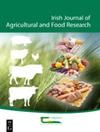Exploring the potential of ingestive behaviour, body measurements, thermal imaging, heart rate and blood pressure to predict dry matter intake in grazing dairy cows
IF 1.4
4区 农林科学
Q3 AGRICULTURE, MULTIDISCIPLINARY
引用次数: 2
Abstract
The objective of this study was to develop and validate models to predict dry matter intake (DMI) of grazing dairy cows using animal energy sinks and status traits in combination with traits related to grazing behaviour, body measurements, thermal imaging, heart rate and blood pressure. The dataset used to develop the models comprised 33 measurements from 113 Holstein-Friesian dairy cows. Multivariable regression models were constructed incorporating each independent variable into a benchmark model incorporating the energy sinks (milk yield [MY], fat %, protein % and body weight [BW]) and status traits (feeding treatment, parity and calving day of year). Of the 33 variables tested, 10 showed an association with DMI (P < 0.25). These variables were incorporated into a backward linear regression model. Variables were retained in this model if P < 0.05. Grazing bout duration and rumination mastication rate were retained in the final model. The inclusion of these variables in the model increased DMI prediction by 0.01 (coefficient of determination [R2] = 0.85) compared to the benchmark model alone (R2 = 0.84). The models were applied to data recorded on an independent herd of 51 dairy cows. The R2 upon validation was 0.80 for the benchmark model and 0.79 for the model incorporating rumination mastication rate and grazing bout duration in combination with the benchmark variables. The separation of grazing bout duration and rumination mastication rate to predict DMI revealed rumination mastication rate slightly increases predictive accuracy upon external validation (R2 = 0.81), whereas grazing bout duration did not (R2 = 0.78). This suggests that grazing bout duration is not a robust trait for DMI prediction. Results from this study suggest that rumination mastication rate can slightly increase the accuracy of DMI prediction surpassing known energy sinks and status traits.探索摄食行为、身体测量、热成像、心率和血压预测放牧奶牛干物质摄取量的潜力
本研究旨在利用动物能量汇和状态性状,结合与放牧行为、身体测量、热成像、心率和血压相关的性状,建立并验证放牧奶牛干物质采食量(DMI)预测模型。用于开发模型的数据集包括113头荷斯泰因-弗里西亚奶牛的33次测量。构建多变量回归模型,将各自变量纳入能量汇(产奶量[MY]、脂肪%、蛋白质%和体重[BW])和状态性状(饲养处理、胎次和产犊天数)的基准模型。在测试的33个变量中,10个显示与DMI相关(P < 0.25)。这些变量被纳入一个反向线性回归模型。若P < 0.05,则模型中保留变量。最终模型保留放牧持续时间和反刍咀嚼率。与单独使用基准模型(R2 = 0.84)相比,将这些变量纳入模型可使DMI预测提高0.01(决定系数[R2] = 0.85)。这些模型应用于51头奶牛的独立牛群的数据记录。基准模型的验证R2为0.80,结合基准变量的反刍咀嚼率和放牧持续时间模型的验证R2为0.79。将放牧持续时间和反刍咀嚼率分离预测DMI,经外部验证反刍咀嚼率略微提高预测准确率(R2 = 0.81),而放牧持续时间没有显著提高预测准确率(R2 = 0.78)。这表明放牧持续时间不是预测DMI的可靠特征。本研究结果表明,反刍咀嚼率可以略微提高超越已知能量汇和状态特征的DMI预测的准确性。
本文章由计算机程序翻译,如有差异,请以英文原文为准。
求助全文
约1分钟内获得全文
求助全文
来源期刊
CiteScore
2.50
自引率
20.00%
发文量
23
审稿时长
>36 weeks
期刊介绍:
The Irish Journal of Agricultural and Food Research is a peer reviewed open access scientific journal published by Teagasc (Agriculture and Food Development Authority, Ireland). Manuscripts on any aspect of research of direct relevance to Irish agriculture and food production, including plant and animal sciences, food science, agri environmental science, soils, engineering, buildings, economics and sociology, will be considered for publication. The work must demonstrate novelty and relevance to the field of research. Papers published or offered for publication elsewhere will not be considered, but the publication of an abstract does not preclude the publication of the full paper in this journal.

 求助内容:
求助内容: 应助结果提醒方式:
应助结果提醒方式:


